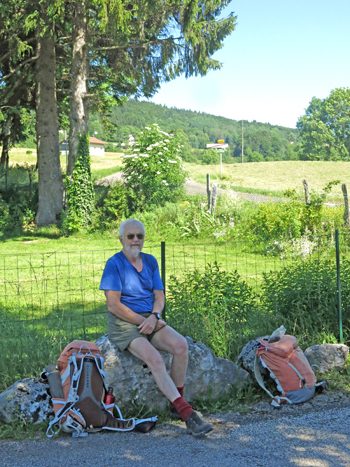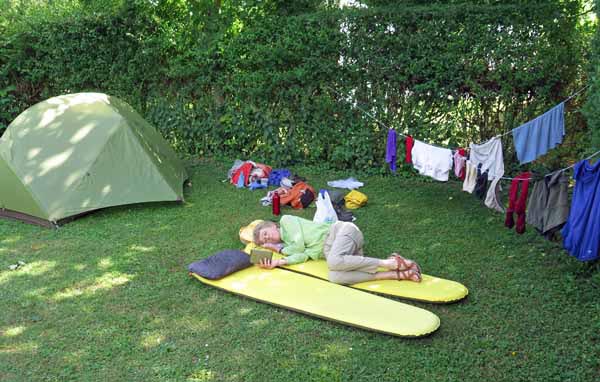Sunday, 18 June 2017
Distance 18 km
Duration 5 hours 5 minutes
Ascent 621 m, descent 631 m
Map 143 of the
Breakfast started at
No other guests appeared in the whole time that we took to demolish the orange juice, yoghurt, apple puree, croissants, a baguette, butter, soft cheese and jam, washed down by much-refilled cups of coffee.

Well padded both inside and out, we emerged straight from the breakfast room into the bright morning. Sunshine whitened the walls of the stony little village as we set off past the chapel and up the steeply rising road.
We passed two sad memorials to resistance fighters killed by the retreating Germans in 1944, still lovingly tended, with fresh flowers at their base.

Then we left the D55 and climbed strenuously in zig-zags as the valley opened out behind us.
At the edge of the hamlet of Plagne we turned away on the D49, which was mercifully flat, and after a kilometre we came to a strange place, called the Dinoplagne.
It was a wide, bare, sloping sheet of rock, and the sign said that there was a line of deep dinosaur footprints in the rock, the trace of a huge mastodon that had walked along what had been a tropical beach 145 million years ago.

The footprints were covered by tarpaulins because they were still being investigated, so we did not actually see them, but we felt awestruck simply to be near them.

Beyond the sheet of rock it was not at all clear where the path went, as there were two or three likely tracks. We chose one at random and it worked (they may have all joined up in the end).
We plunged into a thick forest of birches and pines, criss-crossed confusingly with forestry tracks.

With the help of the compass, we pressed on in a generally westerly direction and after a while we came to a steep escarpment, down which our track went at an angle, delivering us onto a bitumen road at the bottom of the forest.
The land ahead was a bowl of emerald-green farmland, with a promising looking village nesting in it.
This was Charix, and according to our information, it had a bar.

By now it was half past ten, just right for a morning coffee, so we hastened towards it.
Up close, the town was not as picturesque as from above, and the least picturesque building in it was the bar, which turned out to be one half of a metal shed surrounded by newly-laid concrete, the other half being occupied by a small understocked supermarket.

We were informed by a group of bored adolescents hanging about that the whole place was closed, although they did not say why. Luckily our solid hotel breakfast was still coursing through our veins to some extent, so we were not as downcast as we might have been.
A little further on we sat on a low stone wall at the edge of the village and ate some dried fruit with a swig of water.

Then we followed the sunny road for a kilometre or so until the bitumen fizzled out and we found ourselves in a forest, on an old wheel track cut into the slope and buttressed by well-made stone walls. It had the look of a former main thoroughfare.
We descended at a comfortable gradient for about an hour, eventually emerging onto the D74 which was looping its way down the last vertiginous drop into the town of Nantua.
Fortunately there was a foot track that was only half as long (although twice as steep), and we set off down that.
As we did so, a springy looking fellow in running shoes, carrying nothing but a water bottle, appeared from nowhere and skipped down ahead of us.

The track proved to be a maze, rather than a single clear path, and there were slimy roots and slabs of slippery rock at every turn. The forest around us was one of those mossy, primeval ones that never see the sun.
It was slow progress, and we were surprised when we suddenly saw the springy fellow puffing up towards us. He had come to a dead end and was rushing up to try another branch (which could only have taken him out to the bitumen road).
We, meanwhile, had noticed a line of small pilgrim signs attached at intervals to the tree trunks, and by following them we arrived in good order at the first streets of Nantua. By now we had worked out that these pilgrim signs marked the alternative way from Geneva to le Puy, via Lyon and St-Symphorien.
As soon as we left the forest it was punishingly hot, and Sunday afternoon torpor prevailed in the streets – it was1:30 pm.
We found the camping ground beyond a couple of tennis courts and it was pleasantly green and shady, with a high hedge on one side.
The afternoon passed with the minimum of movement on our part, and when the heat began to abate, we emerged in search of a bar and a restaurant. Neither was as easy to find as we had expected in such a touristy town.

After some wandering we found a good-looking restaurant, open every day of the week, with a view over the lake shore.
A bar was harder to find, but in the end we discovered where the locals drank, which was not near the lake at all, but further back, close to the church.
Its terrace was a sort of apron sticking out into the roadway. We ordered glasses of rosé and they came with a dish of rillettes which were much appreciated, as we had forgotten to have lunch.

Back at the restaurant, every table was occupied and we had to wait a little while to get a table.
Across the road was a sort of lakeside park full of plane trees, parked cars, ice-cream vendors and fast food stalls, all looking delightful in the slanting late sunshine.
For dinner we had steak with herb butter and salad, augmented as usual with a mountain of bread and a carafe of red wine.
On the way back to our tent we strolled along the foreshore, where children were playing and adults pleasantly conversing. The last rays of the setting sun burnished the surface of the lake.
We found out from a sign that it was a natural glacial lake, not the result of damming a river as most French lakes are.
In the latter part of the twentieth century it had been so polluted by industrial run-off that every form of life had been asphyxiated, but after a great effort by the local authorities, the water had been cleaned up and the plants and animals had returned.
Previous day: Bellegarde-sur-Valserine to St-Germain-de-Joux



